Performance Evaluation and Oil Displacement Effect of Amphiphilic Polymer Heavy Oil Activator
Abstract
:1. Introduction
2. Results and Discussion
2.1. Performance of Heavy oil Activators
- 1.
- Morphological characteristics of heavy oil activator aggregates
- 2.
- Thickening effect of heavy oil activators
- 3.
- Interface characteristics of heavy oil activators
- 4.
- Viscosity reduction effect
2.2. Microscopic Oil Displacement Visualization Technology
2.2.1. Microscopic Displacement Effect of Heavy Oil Activators
2.2.2. Analysis of the Microdisplacement Mode of the Heavy Oil Activator
2.3. Use of the NMR Technique
2.4. Use of the Laser-Scanning Confocal Microscopy Technology
2.4.1. Microscopic Remaining Oil Displacement Effect
2.4.2. Microscopic Remaining Oil Displacement Effect of Different Components
2.5. Results Obtained Using the CT Scanning Technology
2.5.1. Microscopic Remaining Oil Displacement Effect: The 2D CT Scanning Plane
2.5.2. Microscopic Remaining Oil Displacement Effect: The 3D CT Scanning Plane
3. Experimental
3.1. Materials and Methods
3.2. Methods
3.2.1. Performance of the Heavy Oil Activator Solution
- 1.
- Preparation of the heavy oil activator solution
- 2.
- Characterization of the aggregates formed from the heavy oil activator solution
- 3.
- Viscosity of the heavy oil activator
- 4.
- Interfacial tension of the heavy oil activator
- 5.
- Measurement of contact angle for heavy oil activator
- 6.
- Determination of dispersion system corresponding to heavy oil activator
- 7.
- Viscosity reduction performance of heavy oil activator
3.2.2. Microscopic Residual Distribution Characteristics of the Heavy Oil Activator
- 1.
- Study of the microscopic displacement property of the sample using the visual oil displacement technology (use of the microscopic lithographic glass model)
- ➀
- The crude oil and displacement fluid were filtered, and the microscopic model was vacuumed using a miniature vacuum pump.
- ➁
- Saturated formation water was pumped at the rate of 0.03 mL/min using a micro-pump. The temperature was maintained at 60 °C for 2 h.
- ➂
- Saturated heavy oil was pumped at the speed of 0.03 mL/min using a micropump. The temperature was maintained at 60 °C for 2 h.
- ➃
- We simulated the water flooding process at a constant displacement rate of 0.03 mL/min to drive the oil sample at a steady pace. We studied the microscopic seepage process using the microscopic model. The process was studied using a microscope under water-flooding conditions. The dynamic images of the displacement process were analyzed simultaneously using a high-speed photography system. The process was halted once the moisture content had reached 98%.
- ➄
- We injected the activator solution (0.3 pv) at a constant speed of 0.03 mL/min for the oil flooding to replicate the heavy oil activator flooding process. We studied the microscopic seepage process using the microscopic model (under a microscope) during the heavy oil activator flooding process and recorded the dynamic images of the displacement process using a digital camera.
- ➅
- We studied the microscopic seepage process during the process of water flooding to simulate the subsequent water flooding process. The displacement rate was maintained at 0.03 mL/min, and the process was studied using a microscope. We also recorded the dynamic images of the displacement process using a digital camera. The displacement process was stopped when the moisture content reached 98%.
- ➆
- The image analysis process included both overall and local analysis. These processes helped study the distribution of the remaining oil in the systems. The remaining oil system could be classified into five types based on the pore structure and oil distribution properties of the samples: clusterlike, membranous-like, corner-shaped, columnar-like, and dropletlike (Figure 20).
- 2.
- Use of the nuclear magnetic resonance (NMR) spectroscopy technique for sample analysis
- ➀
- The core was pumped and then saturated with water. Following this, the NMR spectroscopy technique was used to study the core. Subsequently, the core was dried at a temperature of 110 °C, and this was followed by another vacuum-pumping step, during which the heavy-water-treated formation water was pumped into the core.
- ➁
- The core was saturated with oil, and the displacement rate was maintained at 0.1 mL/min under these conditions. The saturated state of the core was scanned using the dynamic NMR technique.
- ➂
- Water flooding was performed on the core sample, and the displacement rate was maintained at 0.1 mL/min. The water content was 98%. The dynamic NMR spectroscopy technique was used to analyze the core during water flooding.
- ➃
- The heavy oil activator was injected into the core at the displacement rate of 0.1 mL/min after water flooding. The heavy oil activator solution (0.3 pv) was injected into the core for dynamic NMR scanning.
- ➄
- A subsequent water flooding step was carried out, and oil could not be produced at the production end after heavy oil activator flooding. The dynamic NMR spectroscopy technique was used to scan the core during displacement.
- 3.
- Use of the laser confocal microscopy technique
- ➀
- The natural core was saturated at the temperature of 60 °C.
- ➁
- The core was water-flooded (water content: 98%), and sample slices were prepared. The saturation level of the remaining oil, the oil/water area, and the contents of different types of remaining oil were analyzed using the laser confocal and computer image processing technologies.
- ➂
- The heavy oil activator was injected into the core, and the activator solution (0.3 pv) was injected into the system. The saturation level of the remaining oil, the oil/water area, and the contents of different types of remaining oil were determined using laser confocal technology.
- ➃
- A subsequent water flooding step was carried out to displace the unproduced oil at the production end, and the microscopic remaining oil in the core was studied using laser confocal technology.
- 4.
- CT scanning technique
- ➀
- Preparation of core: A natural core from a heavy oil reservoir was selected and dried at 110 °C to prepare the core for experiments. The core’s basic physical parameters, including permeability and porosity, were studied before vacuuming. The core was first saturated with water and then with oil. The CT scanning method was used to analyze the core in the initial, bound water state, and the scanning data volume was obtained.
- ➁
- Water flooding was carried out at the displacement rate of 0.1 mL/min until the water content reached 98%. The CT scanning method was used to obtain the scanning data volume.
- ➂
- Heavy oil activator flooding was realized, and the activator (0.3 pv) was injected into the core. The CT scanning method was used for the analysis, and the scanning data volume was obtained.
- ➃
- The core was scanned using the CT technique after water flooding to obtain the scanning data volume. Oil was not produced at the production end, indicating that the process of water flooding could effectively displace oil.
- ➄
- Description of the microscopic remaining oil in the core: the scanning data were processed and analyzed, and a three-dimensional reconstruction was realized.
4. Conclusions
- 1.
- A dense spatial network structure was formed when a heavy oil activator reached a certain concentration. The viscosity of the activator solution sharply increased when the mass concentration was higher than the CAC (1000 mg/L). The activator solution exhibited a good interfacial activity, which significantly reduced the oil–water interfacial tension. The adsorption–permeation–disintegration–dispersion effect on the heavy oil interface resulted in a reduction in the viscosity of heavy oil (maximum reduction achieved: 94%) when the oil/water mass ratio was 1:1, and the activator solution concentration was 1200 mg/L.
- 2.
- The heavy oil activator exhibited viscoelastic characteristics. A strong interaction between the active groups and heavy oil was recorded, and this promoted the formation of an interface film that produced an additional shear effect. This allowed for the effective utilization of membranous-like and corner-shaped remaining oil through a “dragging” mechanism. This resulted in a decrease in the saturation level of the remaining oil from 9.89% (membranous-like) and 6.76% (corner-shaped) to 6.41% and 4.57%, respectively, after water flooding. Furthermore, the activator could increase the viscosity and displacement pressure, enabling the utilization of clusterlike and columnar-like remaining oil. Consequently, the saturation level of the remaining oil decreased from 28.18% (clusterlike) and 9.43% (columnar-like) to 22.60% and 6.82%, respectively, under these conditions.
- 3.
- The NMR results indicated that heavy oil activator flooding significantly impacted the utilization of small and middle pore spaces. Specifically, the recovery degree of middle pores increased from 14.89% to 28.39%, which indicated that a large amount of heavy oil was displaced and recovered from the middle pore spaces after activator flooding. Similarly, the recovery degree of small pores increased from 8.26% to 22.02%, which suggested that the activator was able to effectively mobilize and recover heavy oil from the small pore spaces. These results demonstrate that heavy oil activator flooding can improve the degree of utilization and recovery of oil from previously inaccessible pore spaces.
- 4.
- Laser confocal microscopy was used to study the degree of utilization of the remaining oil after heavy oil activator flooding. The results revealed a significant decrease in the saturation level of the clusterlike and membranelike remaining oil systems (from 23.33% to 18.58% and from 14.14% to 10.26%, respectively). Additionally, a fluorescence detection analysis revealed a slow rate of decline in the light/heavy component contents, indicating a high recovery degree of heavy oil components. The recovery degree increased from 3.22 to 9.10%.
- 5.
- CT scanning technology was used to characterize different types of microscopic remaining oil quantitatively. The swept volume increased, and the clusterlike remaining oil was effectively utilized following heavy oil activator flooding. This resulted in a decrease in the saturation level of the remaining oil from 24.16 to 18.91%. Additionally, the interfacial tension was reduced, and the activator caused a disassembly and dispersion, decreasing the membranous-like and columnlike remaining oil content from 11.42% and 7.49% to 9.41% and 5.44%, respectively.
Author Contributions
Funding
Institutional Review Board Statement
Informed Consent Statement
Data Availability Statement
Conflicts of Interest
Sample Availability
References
- Juan, Z.; Jian, Z.; Guang, Y.; Quan, W.; Yinxian, C.; Hui, Y.; Yiqiang, L.; Jinben, W.; Yuyan, L. Oil Displacement Performance and Viscosity-reducing Effect of Heavy Oil Activator with Amphiphilic Polymer. Oilfield Chem. 2016, 33, 715–719. [Google Scholar]
- Zhang, J.; Hua, Z.; Zhu, Y.J.; Yang, G.; Kang, X.; Wang, X.; Wang, C.; Zhang, H. Disassembling and Coalescing Performance of Amphiphilic Polymer Activator for Heavy Oil and Its Mechanism of Dynamic Profile Control and Oil Displacement. Acta Pet. Sin. 2022, 38, 1325–1335. [Google Scholar]
- Li, J.; Sui, X.G.; Shao, Z.B. Study on micro distribution of remaining oil in pul formation of Daqing Oilfield after polymer flooding. Pet. Geol. Oilfield Dev. Daqing 2005, 24, 26–28. [Google Scholar]
- Guo, J.; Zhao, D.F.; Liang, X.B.; Yang, K.; Li, H.X.; Long, D.X. Quantitative characterization of shale nanopore structure: A case study of Wufeng Formation in southeast Sichuan. Lithol. Reserv. 2020, 32, 113–121. [Google Scholar]
- Song, M.M.; Han, S.Q.; Dong, Y.P.; Chen, J.; Wan, T. Microscopic water displacement efficiency and its main controlling factors in tight sand-stone reservoir. Lithol. Reserv. 2020, 32, 135–143. [Google Scholar]
- Xu, Q.H. Distribution characteristics of micro residual oil after ASP flooding in Daqing Oilfield. Pet. Geol. Oilfield Dev. Daqing 2019, 38, 110–116. [Google Scholar]
- Wang, L.H.; Xia, H.F.; Han, P.H.; Cao, R.B.; Sun, X.D.; Zhang, S.Q. Microscopic characteristics of remaining oil distribution and quantitative characterization of its producibility. Lithol. Reserv. 2021, 33, 147–154. [Google Scholar]
- Yin, S.L.; Chen, G.Y.; Chen, Y.; Wu, X. Control effect of pore structure modality on remaining oil in glutenite reservoir:a case from lower Karamay Formation in block Qidong 1 of Karamay Oilfield. Lithol. Reserv. 2018, 30, 91–102. [Google Scholar]
- Li, Y.Q.; Zhang, J.; Pan, D.; Yan, Y.; Liu, M.X.; Cao, H.; Gao, W.B. Occurrence laws of microscopic remaining oil in high water-cut reservoirs:a case study on blocks Xiaoji and Gangxi in Dagang Oilfield. Xing Jiang Pet. Geol. 2021, 42, 444–449. [Google Scholar]
- Zhang, X.L. Application of frozen slice fluorescence analysis in analyzing the occurrence state of remaining oil after polymer flooding. Pet. Geol. Eng. 2022, 36, 68–71, 77. [Google Scholar]
- Tan, L.; Nie, Z.R.; Xiong, Z.G.; Wang, X.G.; Cheng, H.J.; Chen, L.H.; Zhu, G.F. Study on graded production mechanism of remaining oil inmicro-pores of chemical flooding in conglomerate reservoirs:a case of conglomerate reservoir in Block K7, Karamay Oilfield, Xinjiang. Editor. Dep. Pet. Geol. Recovery Effic. 2021, 28, 107–112. [Google Scholar]
- Jiang, N.; Zhang, Z.; Qu, G.; Zhi, J.; Zhang, R. Distribution Characteristics of Micro Remaining Oil of Class III Reservoirs after Fracture Flooding in Daqing Oilfield. Energies 2022, 15, 3385. [Google Scholar] [CrossRef]
- Zhang, Y.; Zhou, C.; Qu, C.; Wei, M.; He, X.; Bai, B. Fabrication and verification of a glass-silicon-glass micro-/nanofluidic model for investigating multi-phase flow in shale-like unconventional dual-porosity tight porous media. Lab Chip 2019, 19, 4071–4082. [Google Scholar] [CrossRef] [PubMed]
- Zhenqiang, B.A.I.; Shenghe, W.U.; Zhiguo, F.U. The distribution of microcosmic remaining oils after polymer flooding in Daging oilfirld. Acta Pet. Sin. 2015, 34, 117–120. [Google Scholar]
- Zhou, R.N.; Zhang, D.; Wei, J.G. Experimental investigation on remaining oil distribution and recovery performances after different flooding methods. Fuel 2022, 322, 124219. [Google Scholar] [CrossRef]
- Liu, R.; Gou, R.; Pu, W.F.; Ren, H.; Du, D.J.; Chen, P.; Mei, Z.L. Visual laminations combined with nuclear magnetic resonance to study the micro-unrecovered oil distribution and displacement behavior of chemical flooding in a complex conglomerate. Energy Fuels 2019, 33, 4041–4052. [Google Scholar] [CrossRef]
- Gao, H.; Cheng, Y.; Wang, X.J.; Li, T.T.; Yang, L. Experiment of microscopic water displacement mechanism based on NMR displacement technology in nultra-low permeability sand stone. Prog. Geophys. 2015, 30, 2157–2163. [Google Scholar]
- Su, H.; Zhou, F.; Zheng, A.; Wang, L.; Wang, C.; Yu, F.; Kang, L.; Li, J. Heavy oil recovery by alkaline-cosolvent-Polymer Flood: A multiscale research using micromodels and computed tomography imaging. SPE J. 2022, 27, 1480–1492. [Google Scholar] [CrossRef]
- Cheng, Z.; Ning, Z.; Zhao, H.; Wang, Q.; Zeng, Y.; Wu, X.; Qi, R.; Zhang, S. A comprehensive characterization of North China tight sandstone using micro-CT, SEM imaging, and mercury intrusion. Arab. J. Geosci. 2019, 12, 407. [Google Scholar] [CrossRef]
- Chen, Y.; Jha, N.K.; Al-Bayati, D.; Lebedev, M.; Sarmadivaleh, M.; Iglauer, S.; Saeedi, A.; Xie, Q. Geochemical controls on wettability alteration at pore-scale during low salinity water flooding in sandstone using X-ray micro computed tomography. Fuel 2020, 271, 117675. [Google Scholar] [CrossRef]
- Wang, W.; Li, Y.H.; Chen, X.L. Microscope dynamic characterization of oil charging in tight sandstone using a physical simulation experiment. J. Pet. Sci. Eng. 2021, 200, 108379. [Google Scholar] [CrossRef]
- Dehshibi, R.R.; Mohebbi, A.; Riazi, M.; Danafar, F. Visualization study of the effects of oil type and model geometry on oil recovery under ultrasonic irradiation in a glass micro-model. Fuel 2019, 239, 709–716. [Google Scholar] [CrossRef]
- Li, J.; Wu, F.P.; Wang, E.J. Studies on self-associative of a novel cation amphiphilic polymer. Chin. J. Polym. Sci. 2009, 27, 593–596. [Google Scholar] [CrossRef]
- Xu, F.; Chen, Q.; Ma, M.; Wang, Y.; Yu, F.; Li, J. Displacement Mechanism of Polymeric Surfactant in Chemical Cold Flooding for Heavy Based on Microscopic Visualization Experiments. Adv. Geo-Energy Res. 2020, 4, 77–85. [Google Scholar] [CrossRef] [Green Version]
- Ge, J.J.; Wang, D.F.; Zhang, G.C.; Jiang, P.; Liu, H.T. The Effect of Emulsifying Power and Interfacial Tension on Displacement Characteristics for Displacement Systems of Heavy Crude Oil. Acta Pet. Sin. 2009, 25, 690–696. [Google Scholar]
- Wei, C.P.; Li, W.Z.; Wu, G.H.; Deng, H.W.; Sun, Y.H.; Min, L.Y. EOR Mechanism of Viscosity Reducer Flooding in Heavy Oil Reservoirs. Pet. Geol. Recovery Effic. 2020, 27, 131–136. [Google Scholar]
- Jiang, F.; Wang, K.; Skote, M.; Wong, T.N.; Duan, F. The Effects of Oil Property and Inclination Angle on Oil-Water Core Annular Flow Through U-Bends. Heat Transf. Eng. 2018, 39, 536–548. [Google Scholar] [CrossRef]
- Su, H.; Zhou, F.; Liu, Y.; Gao, Y.; Cheng, B.; Dong, R.; Liang, T.; Li, J. Pore-scale investigation on occurrence characteristics and conformance control mechanisms of emulsion in porous media. Pet. Explor. Dev. Online 2021, 48, 1241–1249. [Google Scholar] [CrossRef]
- Li, J.; Jiang, H.; Wang, C.; Zhao, Y.; Gao, Y.; Pei, Y.; Wang, C.; Dong, H. Pore-scale investigation of microscopic remaining oil variation characteristics in water-wet sandstone using CT scanning. J. Nat. Gas Sci. Eng. 2017, 48, 36–45. [Google Scholar] [CrossRef]
- Li, J.; Li, X.R.; Song, M.S.; Liu, H.M.; Feng, Y.C.; Liu, C. Investigating microscopic seepage characteristics and fracture effectiveness of tight sand stones: A digital core approach. Pet. Sci. 2021, 18, 173–182. [Google Scholar] [CrossRef]

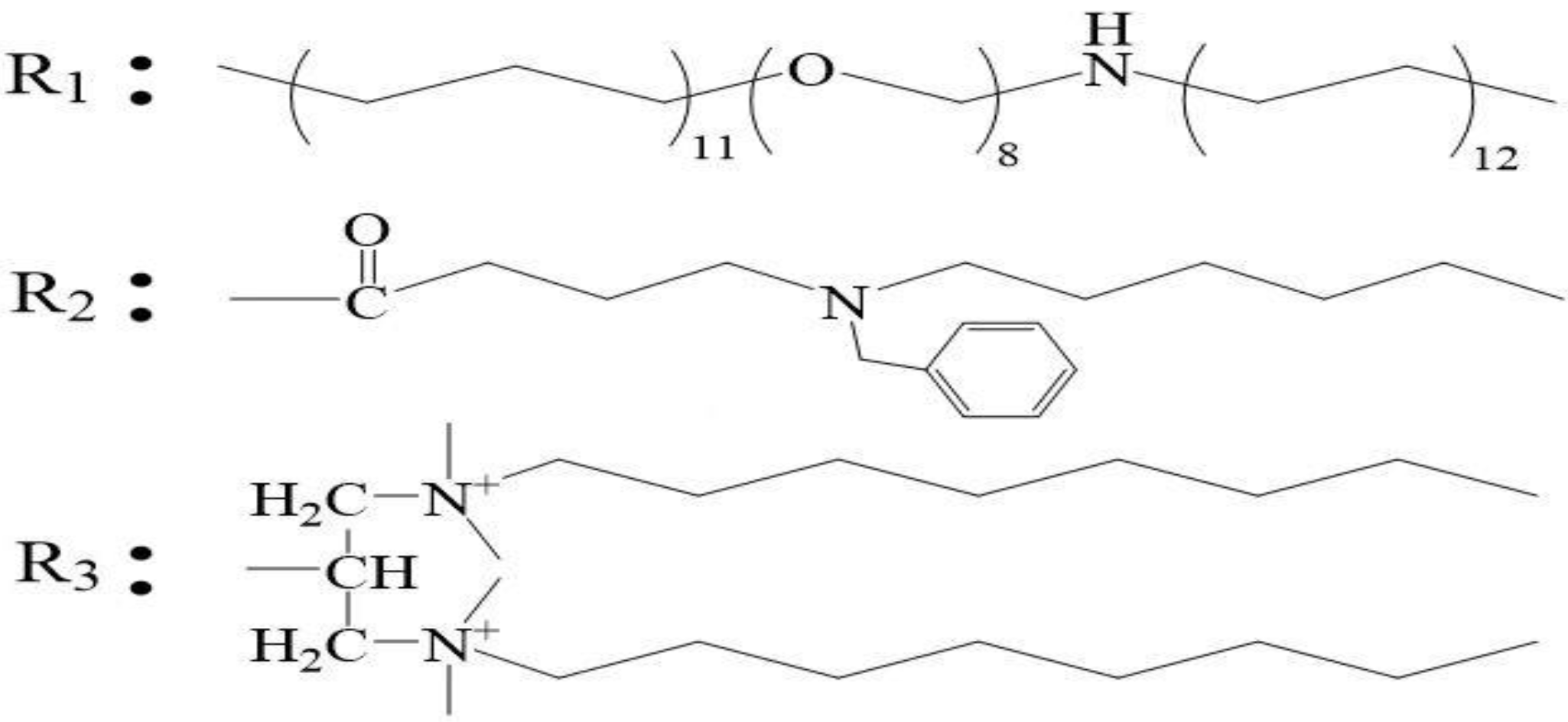

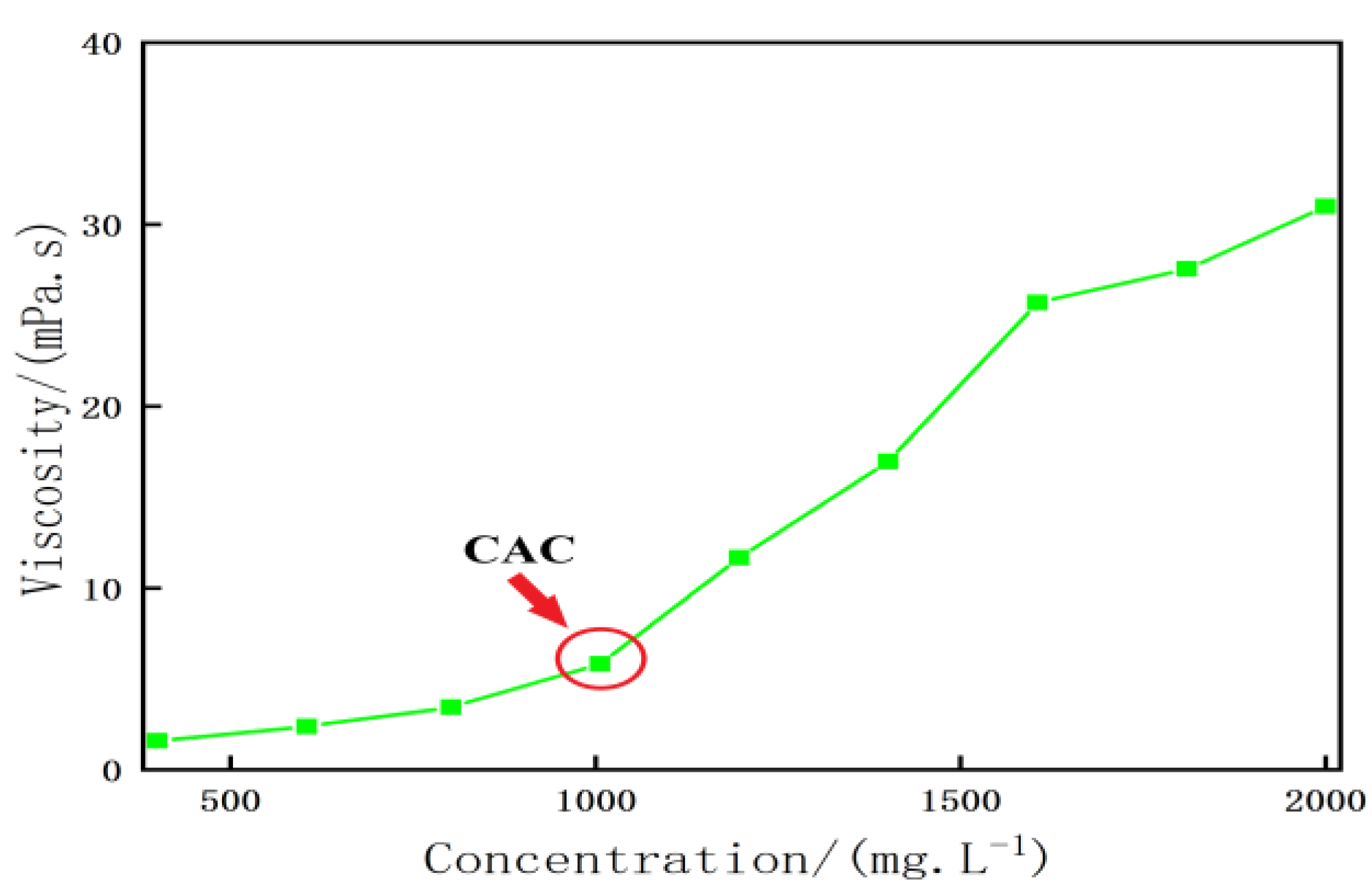
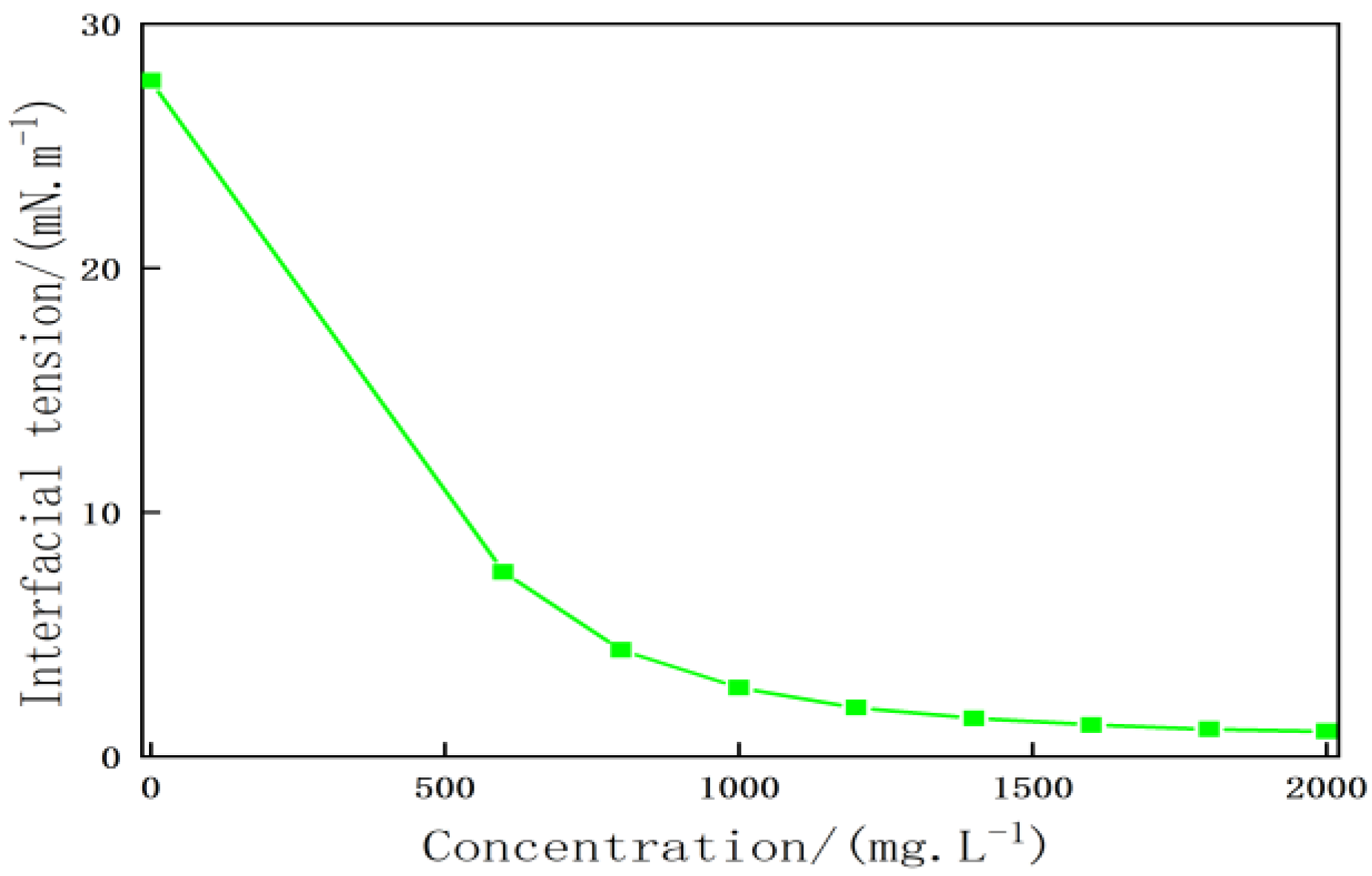

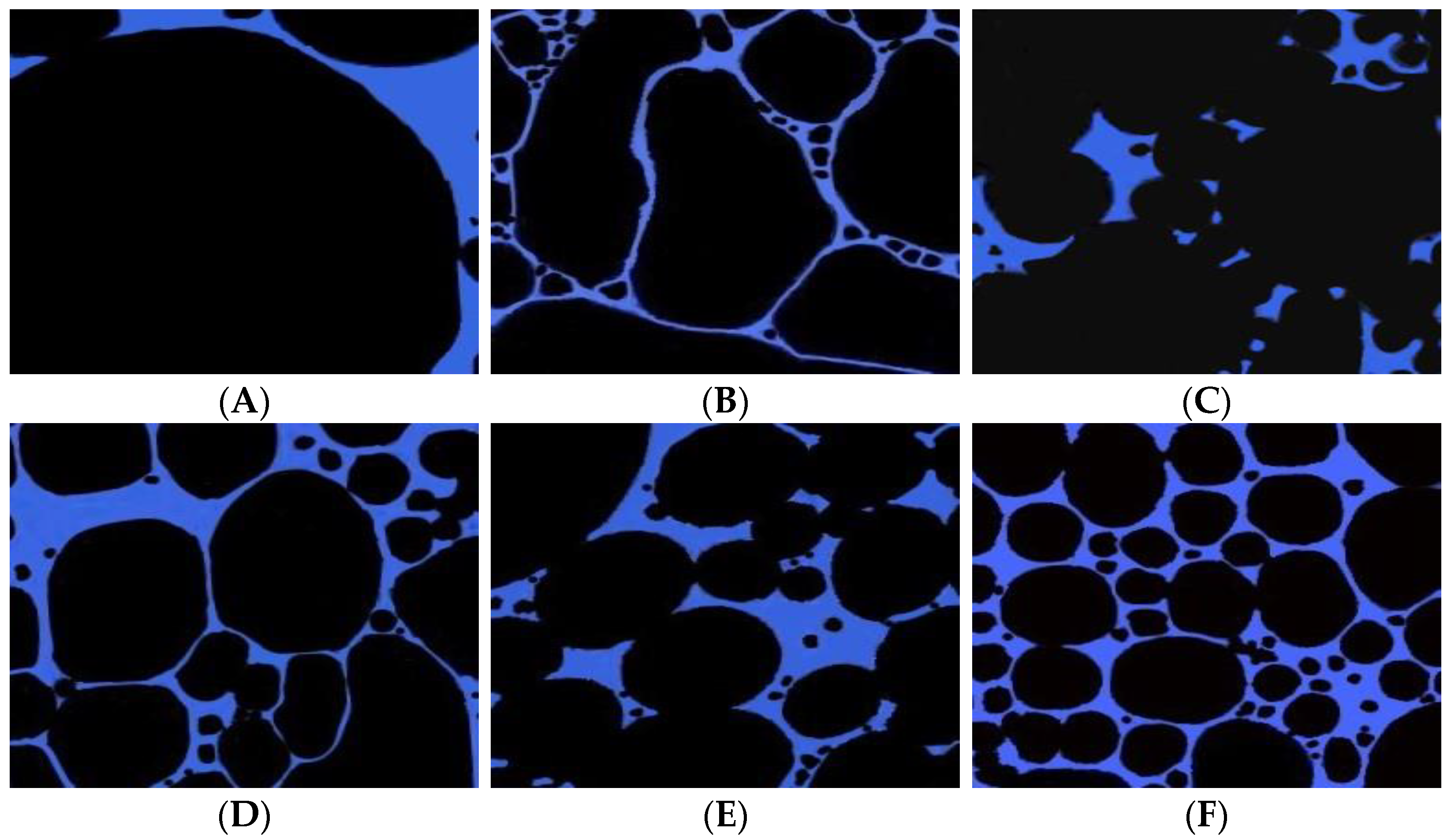
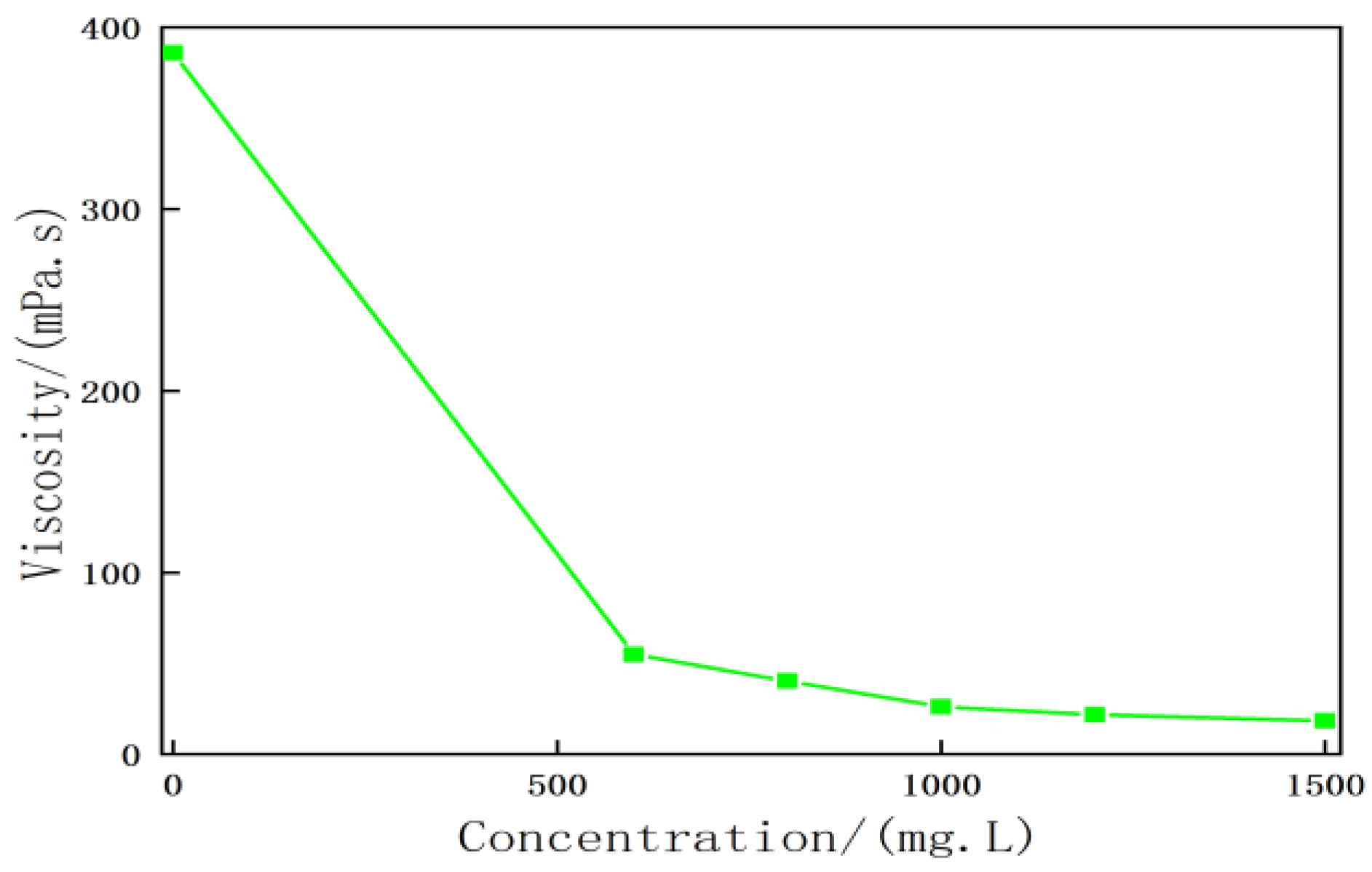


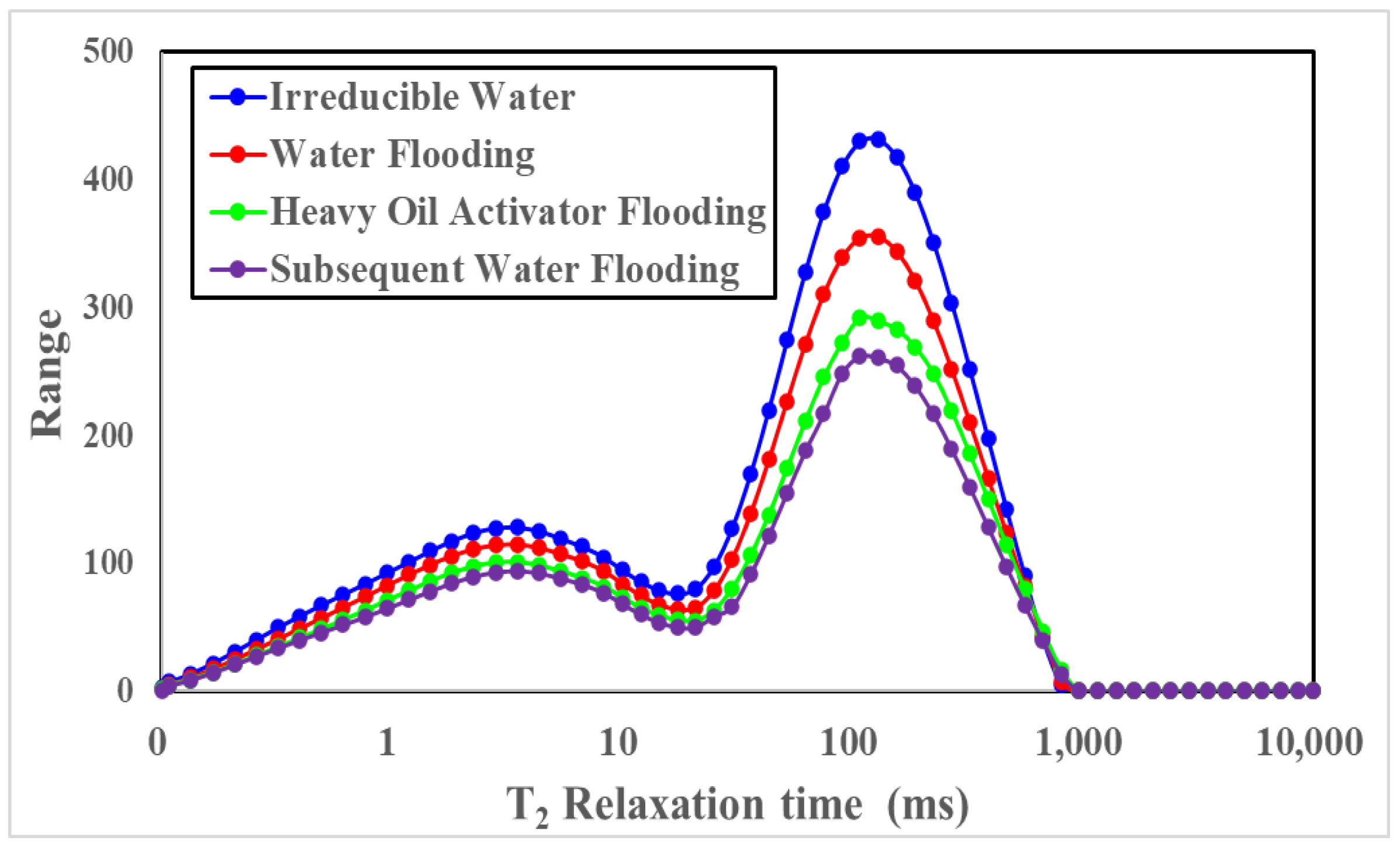








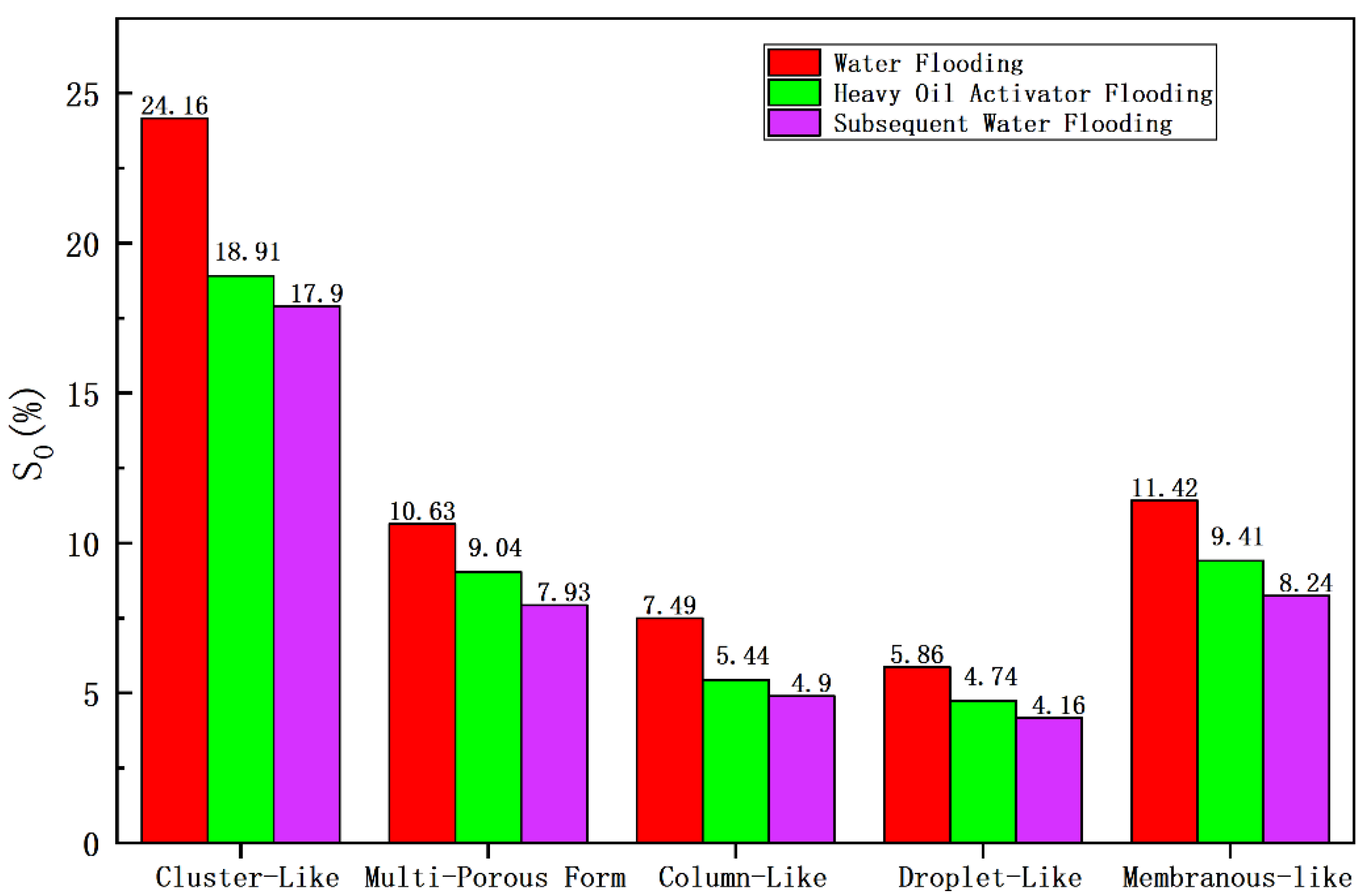


| Displacement Stage | Remaining Oil Saturation Content (%) | ||||
|---|---|---|---|---|---|
| Clusterlike | Corner-Shaped | Columnar-Like | Dropletlike | Membranous-Like | |
| Water flooding | 28.18 | 6.76 | 9.43 | 4.99 | 9.89 |
| Heavy oil activator flooding | 22.60 | 4.57 | 6.82 | 4.63 | 6.41 |
| Displacement State | Oil Saturation (%) | |||
|---|---|---|---|---|
| All Pore Intervals | Less Than 10 ms | 10–100 ms | Greater Than 100 ms | |
| Saturated oil-bound water state | 74.17 | 64.94 | 72.41 | 82.46 |
| Water flooding | 61.63 | 59.58 | 61.63 | 63.12 |
| Heavy oil activator flooding | 50.22 | 50.64 | 51.46 | 48.79 |
| Subsequent water flooding | 45.94 | 48.16 | 47.09 | 43.28 |
| Displacement State | Recovery Degree (%) | Absolute Recovery Degree (%) | Relative Recovery Degree (%) | ||||
|---|---|---|---|---|---|---|---|
| Small Pores (<10 ms) | Middle Pores (10~100 ms) | Macropores (>100 ms) | Small Pores (<10 ms) | Middle Pores (10–100 ms) | Macropores (>100 ms) | ||
| Water flooding | 16.91 | 1.99 | 5.01 | 9.93 | 8.26 | 14.89 | 23.46 |
| Heavy oil activator flooding | 32.29 | 5.31 | 9.74 | 17.28 | 22.02 | 28.93 | 40.84 |
| Subsequent water flooding | 38.06 | 6.23 | 11.77 | 20.11 | 25.84 | 34.97 | 47.51 |
| Displacement State | Recovery Degree (%) | Remaining Oil Saturation Content (%) | ||||||
|---|---|---|---|---|---|---|---|---|
| Bound Remaining Oil | Semibound Remaining Oil | Free Remaining Oil | ||||||
| Membranelike | Particle-Adsorbent-Like | Slitlike | Corner-Shaped | Throatlike | Clusterlike | Intergranular-Adsorption-Like | ||
| Water flooding | 16.81 | 14.14 | 3.79 | 2.14 | 6.52 | 4.38 | 23.33 | 4.81 |
| Heavy oil activator flooding | 34.31 | 10.26 | 3.61 | 1.84 | 4.75 | 3.28 | 18.58 | 3.62 |
| Subsequent water flooding | 39.76 | 9.38 | 3.44 | 1.70 | 3.76 | 2.78 | 17.27 | 3.48 |
| Displacement Stage | Remaining Oil Saturation (%) | Recovery Degree (%) | Ratio of Light/Heavy Components | ||||
|---|---|---|---|---|---|---|---|
| Core | Heavy Components | Light Components | Core | Heavy Components | Light Components | ||
| Initial | 72.86 | 29.39 | 43.48 | - | - | - | 1.48 |
| Water flooding | 59.50 | 27.04 | 32.46 | 18.35 | 3.22 | 15.13 | 1.20 |
| Heavy oil activator flooding | 48.16 | 22.75 | 25.40 | 33.91 | 9.10 | 24.81 | 1.12 |
| Subsequent water flooding | 44.90 | 21.92 | 22.98 | 38.37 | 10.23 | 28.14 | 1.05 |
| Displacement State | Oil Saturation, So (%) | Remaining Oil Saturation (%) | ||||
|---|---|---|---|---|---|---|
| Clusterlike | Multiporous Form | Columnlike | Dropletlike | Membranous-Like | ||
| Initial | 71.32 | 29.12 | 13.25 | 9.14 | 6.77 | 13.03 |
| Water flooding | 59.56 | 24.16 | 10.63 | 7.49 | 5.86 | 11.42 |
| Heavy oil activator flooding | 47.53 | 18.91 | 9.04 | 5.44 | 4.74 | 9.41 |
| Subsequent water flooding | 43.14 | 17.90 | 7.93 | 4.90 | 4.16 | 8.24 |
| Type | Typical Figure | Number of Occupied Pore Throats | Shape Factor | Contact Ratio | Euler Number |
|---|---|---|---|---|---|
| Clusterlike |  | Connected Pore Number > 5 | G > 2 | C ≥ 0.4 | EN ≤ −1 |
| Multiporous form |  | 1 < Connected-Pore Number ≤ 5 | G > 2 | C ≥ 0.4 | EN > −1 |
| Columnar-like |  | Number of Pore-Throats ≤ 1 | G > 2 | C ≥ 0.4 | EN > 0 |
| Dropletlike |  | Number of Pore-Throats ≤ 1 | G ≤ 2 | C = 0 | EN > 0 |
| Membranous-like |  | Thickness < 1/3 of pore throat’s diameter | G > 2 | C < 0.4 | EN > 0 |
Disclaimer/Publisher’s Note: The statements, opinions and data contained in all publications are solely those of the individual author(s) and contributor(s) and not of MDPI and/or the editor(s). MDPI and/or the editor(s) disclaim responsibility for any injury to people or property resulting from any ideas, methods, instructions or products referred to in the content. |
© 2023 by the authors. Licensee MDPI, Basel, Switzerland. This article is an open access article distributed under the terms and conditions of the Creative Commons Attribution (CC BY) license (https://creativecommons.org/licenses/by/4.0/).
Share and Cite
Zhi, J.; Liu, Y.; Chen, J.; Jiang, N.; Xu, D.; Bo, L.; Qu, G. Performance Evaluation and Oil Displacement Effect of Amphiphilic Polymer Heavy Oil Activator. Molecules 2023, 28, 5257. https://doi.org/10.3390/molecules28135257
Zhi J, Liu Y, Chen J, Jiang N, Xu D, Bo L, Qu G. Performance Evaluation and Oil Displacement Effect of Amphiphilic Polymer Heavy Oil Activator. Molecules. 2023; 28(13):5257. https://doi.org/10.3390/molecules28135257
Chicago/Turabian StyleZhi, Jiqiang, Yikun Liu, Jinfeng Chen, Nan Jiang, Dezhu Xu, Lifeng Bo, and Guohui Qu. 2023. "Performance Evaluation and Oil Displacement Effect of Amphiphilic Polymer Heavy Oil Activator" Molecules 28, no. 13: 5257. https://doi.org/10.3390/molecules28135257





